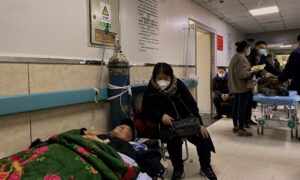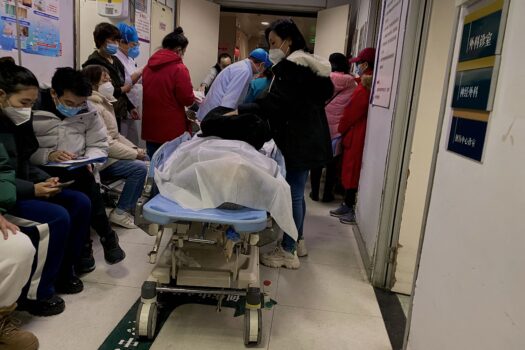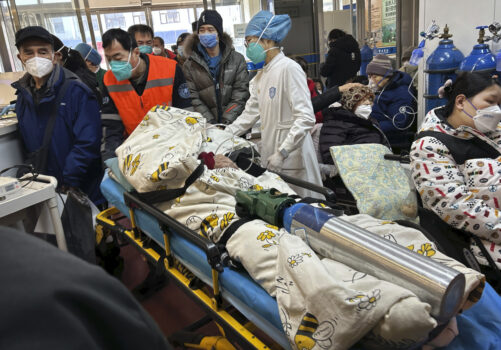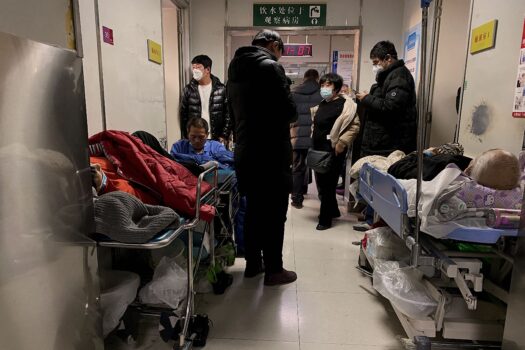Medical System in China’s Hebei Province Is Collapsing: Doctor
China’s northeastern province of Hebei, where Beijing and Tianjin are located, is overwhelmed by an explosive increase of COVID infections. A physician surnamed Chen told The Epoch Times on Dec. 31 that the medical system was inundated with COVID patients and was on the brink of collapse.‘Worse Than Wuhan’ Chen said that the situation in Hebei reminds her of the situation in Wuhan in 2020, and “it’s now worse than Wuhan.” “Many doctors are infected and tested positive (with SARS-Cov-2 virus),” Chen said. “The outpatient and the emergency rooms are all filled with patients. Nurses and doctors are exhausted. There are also non-COVID patients who needed to be operated on. Many doctors [are] with fever but still had to perform the surgeries.” This picture shows a dead person on a gurney at Tianjin First Center Hospital in Tianjin, China, on Dec. 28, 2022. (Noel Celis/AFP via Getty Images) “We usually don’t accept someone if 70 to 80 percent of their lungs are white (as seen in X-ray). We only take a patient when the lungs are black in the center (as seen in X-ray). The person usually coughs and has difficulty breathing, but the blood oxygen level has to be above 80 percent,” Chen said. The hospitals do not accept those with light symptoms. Chen said that among the patients she encountered, most of them had severe symptoms. “There are also plenty [of] people who died before they got assigned a bed in the hospital. There are no beds available now [in the hospital].” System Collapsing Chen said that the medical system is in a chaotic state. Without sufficient preparation, any part of the system can break at any time. “There is no ventilator, no bed, no pillow, no blanket. Patients have to bring their own blankets and pillows. There are not enough nurses and doctors. There is not enough space.” Chen added that the doctors were asked to work around the clock, but “there is no medicine, what can the doctors do?” An HIV drug called Azvudine is in short supply. Chen said, “Azvudine is in high demand. It’s used to treat AIDS, but now it is in low supply. 1,000 capsules are gone in a blink of an eye. “Also, Pfizer’s drugs are not only expensive, but also only for those privileged [like higher ranking officials]. The common folks can’t get them.” ’85 Percent Infected’ A patient on oxygen is wheeled on a gurney into a busy emergency room at a hospital in Beijing, China, on Jan. 2, 2023. (Getty Images) Chen told The Epoch Times: “Among the people around me, it is difficult to find one person who is not infected. I think about 85 percent of the population is infected. Some have severe symptoms, some already died. It was very quick. “I don’t know if the virus is Omicron or not, but I know it is very scary. “Only a couple of days after the opening up [with zero-COVID lockdown ended], our entire department tested positive. The speed this virus spreads is unimaginable. It is not as simple as wearing the mask.” No Real Data A Chinese doctor named Yu Xiangdong, who was removed from his post as the deputy director of the Hematology and Rheumatology department in a hospital in Hubei Province, wrote on the Chinese social media app WeChat about his experience being infected. Yu said that the symptoms started on Dec. 15 with fever, cough, and lightheadedness. On the second day, he slept all day and the fever went away on the third day. But the cough and runny nose persisted. “It’s day 13, but they are still not cleared. This is not a simple cold; it’s very troublesome.” Yu’s father died on Dec. 23 at the age of 79. “From infection to death, it took only 3 days,” he said. Yu also wrote, “There is nowhere to find real data, such as asymptomatic cases, vaccination rate, death rate, severe symptoms rate, medicine efficacy, etc.” The Epoch Times reached out to Yu and he said “it was not convenient for him to be interviewed.” COVID-19 patients on gurneys at Tianjin First Center Hospital in Tianjin, China, on Dec. 28, 2022. (Noel Celis/AFP via Getty Images) Airfinity, a predictive health analytics firm, updated its data on Jan. 3, showing that daily infections are 2.17 million, and daily deaths are 14,000 in China. The cumulative number of infections since Dec. 1 was 28.5 million, with 161,800 deaths. Its model predicts two peaks to be on Jan. 13 and on Mar. 3, “where daily cases are likely to reach 4.2 million.” Li Xinan contributed to this report. Kelly Song covers China-related matters and health issues for The Epoch Times. She is based in the United States. Have a tip? [email protected]

China’s northeastern province of Hebei, where Beijing and Tianjin are located, is overwhelmed by an explosive increase of COVID infections. A physician surnamed Chen told The Epoch Times on Dec. 31 that the medical system was inundated with COVID patients and was on the brink of collapse.
‘Worse Than Wuhan’
Chen said that the situation in Hebei reminds her of the situation in Wuhan in 2020, and “it’s now worse than Wuhan.”
“Many doctors are infected and tested positive (with SARS-Cov-2 virus),” Chen said. “The outpatient and the emergency rooms are all filled with patients. Nurses and doctors are exhausted. There are also non-COVID patients who needed to be operated on. Many doctors [are] with fever but still had to perform the surgeries.”

“We usually don’t accept someone if 70 to 80 percent of their lungs are white (as seen in X-ray). We only take a patient when the lungs are black in the center (as seen in X-ray). The person usually coughs and has difficulty breathing, but the blood oxygen level has to be above 80 percent,” Chen said.
The hospitals do not accept those with light symptoms. Chen said that among the patients she encountered, most of them had severe symptoms.
“There are also plenty [of] people who died before they got assigned a bed in the hospital. There are no beds available now [in the hospital].”
System Collapsing
Chen said that the medical system is in a chaotic state. Without sufficient preparation, any part of the system can break at any time. “There is no ventilator, no bed, no pillow, no blanket. Patients have to bring their own blankets and pillows. There are not enough nurses and doctors. There is not enough space.”
Chen added that the doctors were asked to work around the clock, but “there is no medicine, what can the doctors do?”
An HIV drug called Azvudine is in short supply. Chen said, “Azvudine is in high demand. It’s used to treat AIDS, but now it is in low supply. 1,000 capsules are gone in a blink of an eye.
“Also, Pfizer’s drugs are not only expensive, but also only for those privileged [like higher ranking officials]. The common folks can’t get them.”
’85 Percent Infected’

Chen told The Epoch Times: “Among the people around me, it is difficult to find one person who is not infected. I think about 85 percent of the population is infected. Some have severe symptoms, some already died. It was very quick.
“I don’t know if the virus is Omicron or not, but I know it is very scary.
“Only a couple of days after the opening up [with zero-COVID lockdown ended], our entire department tested positive. The speed this virus spreads is unimaginable. It is not as simple as wearing the mask.”
No Real Data
A Chinese doctor named Yu Xiangdong, who was removed from his post as the deputy director of the Hematology and Rheumatology department in a hospital in Hubei Province, wrote on the Chinese social media app WeChat about his experience being infected.
Yu said that the symptoms started on Dec. 15 with fever, cough, and lightheadedness. On the second day, he slept all day and the fever went away on the third day. But the cough and runny nose persisted. “It’s day 13, but they are still not cleared. This is not a simple cold; it’s very troublesome.”
Yu’s father died on Dec. 23 at the age of 79. “From infection to death, it took only 3 days,” he said.
Yu also wrote, “There is nowhere to find real data, such as asymptomatic cases, vaccination rate, death rate, severe symptoms rate, medicine efficacy, etc.” The Epoch Times reached out to Yu and he said “it was not convenient for him to be interviewed.”

Airfinity, a predictive health analytics firm, updated its data on Jan. 3, showing that daily infections are 2.17 million, and daily deaths are 14,000 in China. The cumulative number of infections since Dec. 1 was 28.5 million, with 161,800 deaths. Its model predicts two peaks to be on Jan. 13 and on Mar. 3, “where daily cases are likely to reach 4.2 million.”
Li Xinan contributed to this report.













